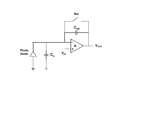VeeJayy
Junior Member level 1
Hello,
I have attached a picture of the capacitive transimpedance amplifier which is generally used in image sensors. Can anyone help me understand the use of the input capacitor 'Ca'?
I know that the photo diode in itself has a diffusion capacitance which gives a measure of the charge stored with respect to the photons incident on it. But what is the necessity of the additional capacitance Ca here?
Thank you
I have attached a picture of the capacitive transimpedance amplifier which is generally used in image sensors. Can anyone help me understand the use of the input capacitor 'Ca'?
I know that the photo diode in itself has a diffusion capacitance which gives a measure of the charge stored with respect to the photons incident on it. But what is the necessity of the additional capacitance Ca here?

Thank you